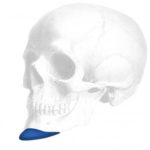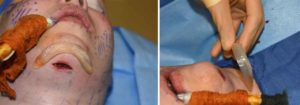Background: Besides rhinoplasty surgery for the nose, chin augmentation is the second most common facial reshaping procedure. What the nose and chin share in common is that they are both central projecting features of the face. While there are a variety of chin reshaping procedures that can be done, augmentation is by far the most common.
Chin augmentation typically refers to a horizontal increase in the forward position of the soft tissue chin pad. This is typified by almost every imaged and actual before and after surgical result being shown in the side view. While this is a valuable perspective on which to judge chin projection, it is only a 2D rendering (horizontal and vertical) of a 3D structure. The oblique and frontal views provides how the chin can or does look with a view of its effect on width and as well as another angle on its verticality.
The vertical length of the chin is an important dimension to consider when augmenting the chin as well. Some chins that are horizontally deficient are vertically short as well. Most standard chin implants are resigned to sit on the bone and create a purely horizontal effect. While it is true these chin implants can be positioned slightly lower in the chin to gain a slight amount of vertical increase that is not the same as creating a truly combined horizontal-vertical chin augmentation effect. Only a vertical lengthen chin imply can do so.
Case Study: This female wanted to have an overall stronger chin that provides both an equal amount of horizontal and vertical augmentation


Highlights:
1) Chin augmentation is typically perceived as the need for an increase in horizontal projection.
2) Some chins that need a horizontal dimensional increase may also benefit but some vertical increase as well.
3) A 45 degree increase in projection of the mandibular symphysis requires a vertical lengthening chin implant.
Dr. Barry Eppley
Indianapolis, Indiana




